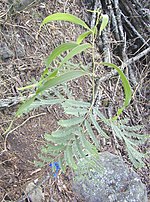Metrosideros polymorpha, the ʻōhiʻa lehua, is a species of flowering evergreen tree in the myrtle family, Myrtaceae, that is endemic to the six largest...
20 KB (2,020 words) - 14:03, 28 September 2024
umbellata) of New Zealand, and ʻōhiʻa lehua (M. polymorpha) from the Hawaiian Islands. Metrosideros is one of the most widely spread flowering plant...
13 KB (960 words) - 20:16, 12 November 2024
(Wikstroemia spp.), loulu fan palms (Pritchardia spp.), ʻōhiʻa lehua (Metrosideros polymorpha), and lama (Diospyros sandwicensis). Mixed mesic forests, at 750...
12 KB (1,009 words) - 18:50, 24 May 2024
sandwicense (or māmane–naio) forest on its flanks, and an Acacia koa–Metrosideros polymorpha (or koa–ʻōhiʻa) forest, now mostly cleared by the former sugar...
105 KB (10,395 words) - 14:26, 22 November 2024
lies within the national park. It offers aʻe ferns, ʻōhiʻa trees (Metrosideros polymorpha), and hapu’u of genus Cibotium are common. The park hosts many...
102 KB (10,371 words) - 12:49, 13 October 2024
opposition in 2021. Metrosideros robusta, northern rātā Metrosideros umbellata, southern rātā Metrosideros bartlettii, Bartlett's rātā Metrosideros parkinsonii...
22 KB (1,387 words) - 00:52, 12 November 2024
"rainbow colored", probably due to the predominant color of the Metrosideros polymorpha flower: an animal that floats through the air, from one lehua to...
8 KB (860 words) - 20:54, 9 September 2024
rain to fall. Lehua ʻāpane or ʻōhiʻa ʻāpane is an ʻōhiʻa tree (Metrosideros polymorpha) with dark red blossoms. ʻAkaka Falls is located on Kolekole Stream...
4 KB (399 words) - 07:54, 9 April 2024
Martinia polymorpha, a perennial herb Medicago polymorpha, a plant native to the Mediterranean Basin Melanoides polymorpha, a freshwater snail Metrosideros polymorpha...
897 bytes (125 words) - 21:49, 27 September 2015
closely related to the widespread and highly variable ʻōhiʻa lehua (Metrosideros polymorpha), found throughout the islands. Lehua papa, however, is restricted...
2 KB (180 words) - 00:25, 30 January 2023
it to grow in very young volcanic soils. Koa and ʻōhiʻa lehua (Metrosideros polymorpha) dominate the canopy of Hawaiian mixed mesic forests. It is also...
20 KB (1,944 words) - 23:44, 1 September 2024
breed only on the Big Island, in stands of native ʻōhiʻa lehua (Metrosideros polymorpha) trees. The species was protected as an endangered species in the...
6 KB (668 words) - 14:24, 11 June 2024
(Argyroxiphium grayanum), a distinctive bog variety of ʻōhiʻa lehua (Metrosideros polymorpha var. pseudorugosa) and many lobelioid species. Due to the mountain...
5 KB (449 words) - 00:52, 4 August 2024
are now rare; C. oppositifolia is listed as Endangered. Also see Metrosideros polymorpha Wagner, W. L., D. R. Herbst, and S. H. Sohmer. 1990. Manual of...
839 bytes (86 words) - 18:30, 28 October 2023
small group of islands, Metrosideros kermadecensis is listed as range restricted, but is not regarded as threatened. Metrosideros kermadecensis is widely...
3 KB (247 words) - 12:32, 12 November 2024
of old canvas tents". Today, the flowers of the native ʻōhiʻa (Metrosideros polymorpha) are favored by a number of nectarivorous honeycreepers. The wide...
26 KB (2,115 words) - 00:03, 23 August 2024
dependent on high-elevation mesic and wet forests of ʻōhiʻa lehua (Metrosideros polymorpha) and koa (Acacia koa). These two species of trees attract insects...
5 KB (503 words) - 14:24, 28 October 2024
the ʻiʻiwi shifted to nectar from the blossoms of ʻōhiʻa lehua (Metrosideros polymorpha) trees. ʻIʻiwi also eat small arthropods. In the early winter in...
22 KB (2,522 words) - 00:28, 6 August 2024
conservation of the most dominant rainforest tree in Hawai'i, Metrosideros polymorpha. Unfortunately, the progression of the malignant lymphoma slowed...
15 KB (1,646 words) - 20:45, 14 February 2024
ʻākohekohe is a nectarivore that feeds on the flowers of ʻōhiʻa lehua (Metrosideros polymorpha) high up in the canopy. It is an aggressive bird and will drive...
7 KB (868 words) - 02:03, 13 February 2024
specific type of lei and a color. Hawaiʻi: red, ʻōhiʻa lehua (Metrosideros polymorpha) Maui: pink, lokelani (Rosa damascena) Kahoʻolawe: gray or silver...
20 KB (2,167 words) - 05:30, 12 November 2024
ferns, and grass are common, and even a few ōhiʻa lehua trees (Metrosideros polymorpha) grow along the summit. Many of the collapse craters in particular...
34 KB (3,330 words) - 03:45, 21 August 2024
it feeds on insects, and buds and blossoms of the ʻōhiʻa lehua (Metrosideros polymorpha). It was known to have been a nomadic forager that made strong...
8 KB (833 words) - 14:21, 28 October 2024
snails, insects, and spiders and it nested in native ‘ōhi‘a lehua (Metrosideros polymorpha) forests. Po’ouli relied more on an insectivorous diet because...
17 KB (2,045 words) - 05:26, 1 October 2024
and Oʻahu. ʻApapane commonly forage in the canopies of ʻōhiʻa (Metrosideros polymorpha) trees, drinking nectar from the flowers and serving as important...
14 KB (1,477 words) - 23:32, 21 August 2024
been well studied. Species include the dwarfed ʻōhiʻa lehua tree (Metrosideros polymorpha), the Maui violet (Viola mauiensis), a variety of Hawaiian lobelioids...
7 KB (560 words) - 17:06, 30 October 2024
Metrosideros macropus, the lehua mamo or 'ohi'a, is a species of tree in the eucalyptus family, Myrtaceae. It is endemic to the island of Oʻahu in the...
2 KB (140 words) - 19:37, 21 June 2022
the forms of ʻIeʻIe (Freycinetia arborea) vine, ʻŌhiʻa Lehua (metrosideros polymorpha)flower, ʻulu (breadfruit), niu (only the coconut tree trunk), and...
7 KB (736 words) - 02:49, 18 November 2024
species in its habitat include koa (Acacia koa), ʻōhiʻa lehua (Metrosideros polymorpha), ʻōlapa (Cheirodendron trigynum), and lapalapa (C. platyphyllum)...
6 KB (511 words) - 11:20, 22 September 2024



























